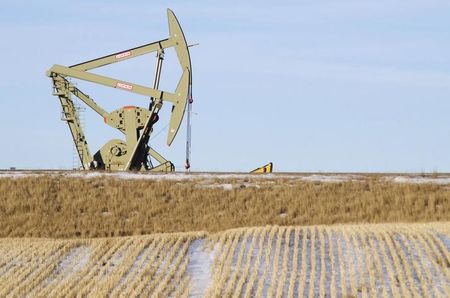Commodities
Oil prices boosted by China manufacturing activity data; weaker dollar helps

Investing.com– Oil prices rose Monday, benefiting from stronger-than-expected Chinese manufacturing activity data, suggesting a recovery in the world’s second-largest economy and major crude importer.
At 08:40 ET (12:40 GMT), Brent crude futures rose 0.8% to $85.64 a barrel, and U.S. West Texas Intermediate crude futures climbed 0.7% to $82.08 a barrel.
Both contracts were sitting on bumper gains through June as geopolitical ructions in the Middle East and Russia pushed up concerns over potential disruptions in supply, which saw traders attach a greater risk premium to crude.
Oil benefits from Chinese manufacturing strength
This positive tone was extended Monday after Chinese manufacturing activity grew more than expected in June, private purchasing managers index data showed on Monday.
The rose 51.8 in June, compared to expectations for a reading of 51.5, and the prior month’s reading of 51.7.
The reading has overshadowed data released on Sunday, which showed China’s manufacturing sector shrank for a second consecutive month in June. A reading below 50 indicates contraction.
Also helping the tone was a fall in the , extending declines from Friday after – which is the Fed’s preferred inflation gauge- showed inflation eased mildly in May.
The reading spurred some optimism that U.S. inflation was cooling, and saw traders ramp up bets on a 25 basis point rate cut in September, which weighed on the greenback.
A softer dollar benefits oil demand by making the commodity cheaper for international buyers.
Fed cues could move the dollar
The focus this week is on signals from the Fed, with set to speak on Tuesday, while the are due on Wednesday.
Key data is also due on Friday, with the strength of the labor market a key consideration for the Fed in moving interest rates.
But even with positive signals on interest rates, inventory data released last week showed that U.S. fuel demand remained weak despite increased travel during the summer season.
Hurricane season in Americas
Traders are also watching for the impact hurricanes have on oil and gas production and consumption in the Americas.
The Atlantic hurricane season started with Hurricane Beryl on Sunday, with a warning is in effect in Barbados, St Lucia, St Vincent and the Grenadines and Tobago.
On Friday the Energy Information Administration reported that oil production and demand for major products rose to a four-month high in April, but a severe hurricane in the important Gulf of Mexico producing region could impact this.
(Ambar Warrick contributed to this article.)
Commodities
Oil prices rise; U.S. crude inventories plunge, Russia-Ukraine truce eyed
Commodities
India’s Reliance to stop buying Venezuelan oil over US tariffs, sources say
Commodities
Oil prices climb on Venezuela supply worries

 Forex3 years ago
Forex3 years agoForex Today: the dollar is gaining strength amid gloomy sentiment at the start of the Fed’s week

 Forex3 years ago
Forex3 years agoUnbiased review of Pocket Option broker

 Forex3 years ago
Forex3 years agoDollar to pound sterling exchange rate today: Pound plummeted to its lowest since 1985

 Forex3 years ago
Forex3 years agoHow is the Australian dollar doing today?

 Cryptocurrency3 years ago
Cryptocurrency3 years agoWhat happened in the crypto market – current events today

 World3 years ago
World3 years agoWhy are modern video games an art form?

 Commodities3 years ago
Commodities3 years agoCopper continues to fall in price on expectations of lower demand in China

 Economy3 years ago
Economy3 years agoCrude oil tankers double in price due to EU anti-Russian sanctions























